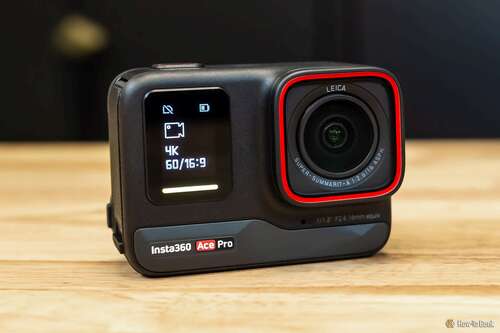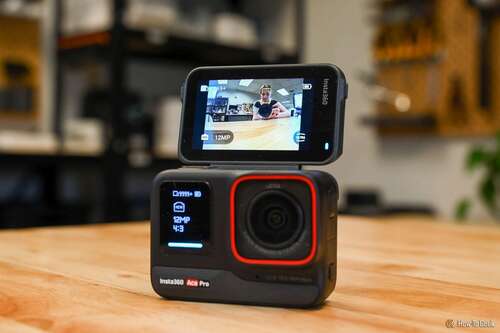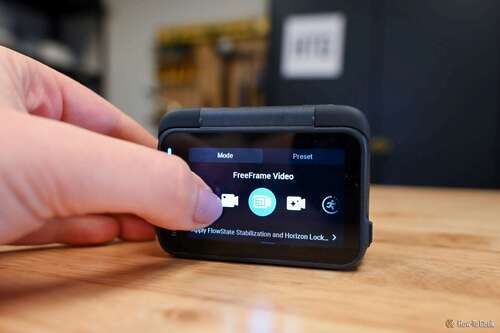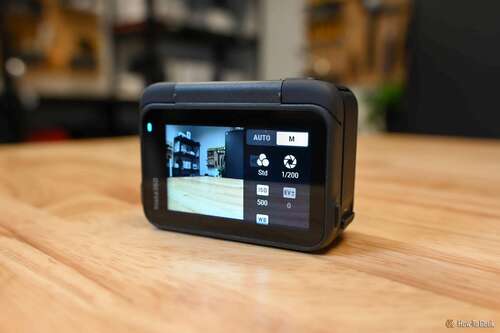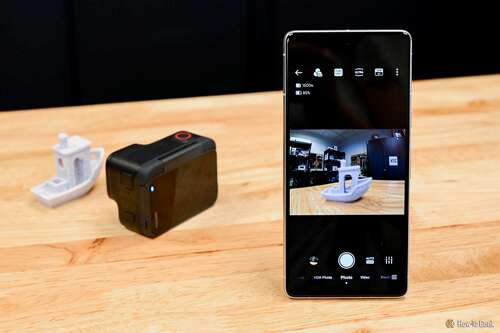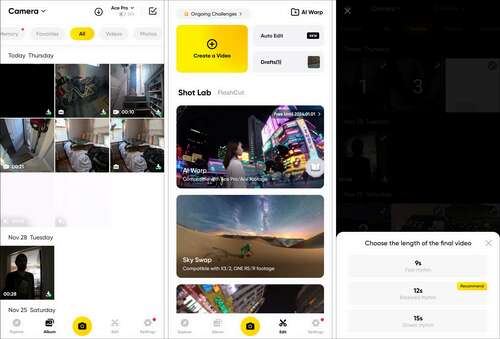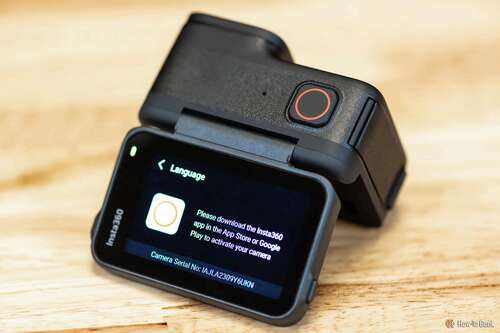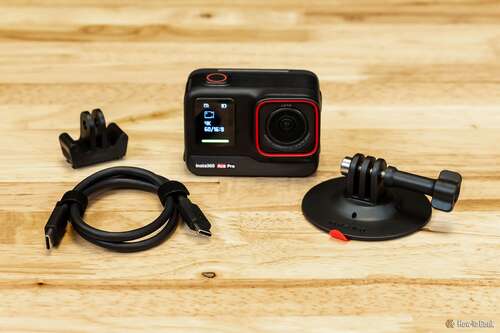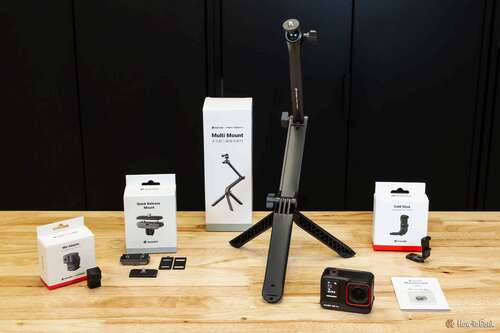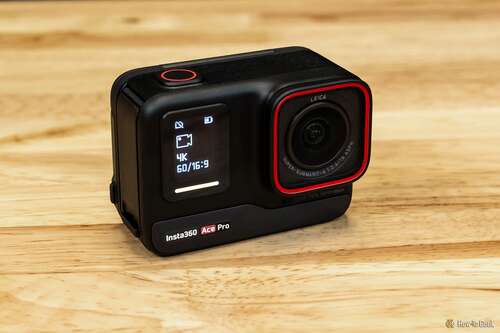Key Takeaways
- The Insta360 Ace Pro offers a must-have flip-up touchscreen for easy viewing and recording, along with a large sensor and 8K video recording capability.
- The camera’s low-light performance is impressive, thanks to its 1/1.3-inch sensor and AI chip, making it ideal for capturing high-quality footage in dark environments.
- While the Insta360 app is decent, the camera needs to be activated with the app before use, and the app lacks some editing features appreciate video rotation. However, the overall software experience is pleasant to use.
Insta360 has been making cameras since 2016, but as the name gives away, the majority of those devices have been 360-degree cameras. The company hasn’t dabbled much in the world of GoPro-appreciate action cameras. With the Insta360 Ace Pro, they’re diving in head first.
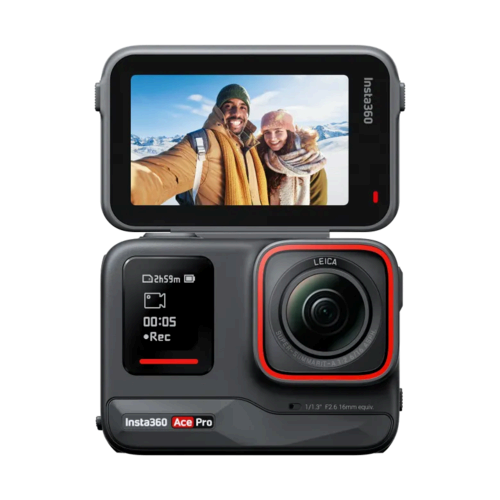

Insta360 Ace Pro
The Insta360 Ace Pro is an action camera with a 180-degree flip display and a large 1/1.3-inch sensor with Leica lens.
- Sensor Size
- 1/1.3″
- Video Resolution
- 8K, 4K, 2.7K, 1440p, 1080p
- Photo Resolution
- 48, 36, 12, 9MP
- Battery
- 1650mAh
- Connection
- Bluetooth, Wi-Fi
- Size
- 71.9mm x 52.15 mm x 38.5mm
- Weight
- 179.8g
- Water Resistance
- 33 feet
- Lens
- 151-degree Wide-Angle Leica f/2.6 Lens
- Storage
- No internal storage, microSD cards up to 1 TB
- Flip up touch screen feels appreciate a must-have
- Large sensor
- 8K video recording
- Great low-light performance
- Plenty of mounting options
- Pricier than similar action cameras
- Need to activate with the app before using
- Insta360 app is just okay
Insta360 Ace Pro Design: Flip Into the Future
The Insta360 Ace Pro has a compact, fairly standard action camera design. The boxy body is made of black matte metal with red accents. The lens itself is protected by a glass guard that seems appreciate it should be removable but, unfortunately, must be professionally replaced.
The camera has a standard 1/4-20 tripod mount on the bottom and a magnetic quick-release system that works with various accessories (more on those later). The camera also has a USB-C port for charging and data transfer, and a microSD card slot underneath a cover on one side. The opposite side has a door for removing the 1650mAh battery.
The most distinctive feature of the Insta360 Ace Pro is the 2.4-inch flip touchscreen that can be rotated 180 degrees to face the front or the back of the camera. The screen is held closed by buttons on either side, which is a great idea for durability. Many action cameras have a small secondary display that’s used as a viewfinder when holding it in selfie mode. The full-size flip screen on the Ace Pro is a far more practical feature.
Speaking of buttons, the Insta360 Ace Pro has two physical buttons: a power button and a shutter button. The power button can also be used to switch between the camera’s many modes and mark clips as important while recording. This makes it easier to find specific parts of a video later on. Besides snapping photos and starting recording, the shutter button can quickly start capturing when it’s pressed while the camera is off (if you enable the feature).
The aforementioned 1650mAh battery can last up to 100 minutes of continuous 4K recording at 30fps. The battery can be charged via the USB-C port, which supports 30W fast charging that can charge the battery to 80% in just 22 minutes. A spare battery costs around $35, and the Fast Charge Hub can charge up to three batteries at a time.
All in all, this is a well-designed little camera. The typical boxy action camera design is tried and true. It can sit perfectly stable on flat surfaces, and I found it to be very easy to hold. The small size presented some challenges for me—videos with my finger slightly in view—but that’s more a me problem than an Insta360 problem.
Insta360 Ace Pro Video Recording: Powerful Where It Counts
Video recording is the name of the game when it comes to action cameras. Admittedly, I don’t record a lot of videos in my daily life. I’m an active person, but not an extreme sports athlete. Still, I was able to find a few cool uses for the Insta360 Ace Pro’s high-quality video recording.
The camera is capable of recording video at up to 8K resolution at 24fps or 4K resolution at up to 120fps. The camera can also record slow-motion video at up to 240fps at 1080p resolution. The camera supports H.265 and H.264 video codecs and can record at up to 170Mbps bitrate. There are tons of video modes to select from as well—I was kinda overwhelmed by the choices, to be honest. There’s Video, FreeFrame, PureVideo, Slow Motion, Starlapse, Timelapse, TimeShift, and Loop Recording.
- Video: The standard mode that records video with FlowState stabilization and the built-in Active HDR feature, which enhances the dynamic range and color accuracy of the footage. The Active HDR feature can also be turned off if you don’t appreciate the look, but I kept it on.
- FreeFrame: This mode allows you to reframe footage after recording. It records video with a 4:3 aspect ratio and a wider field of view than the standard 16:9 aspect ratio. This gives you more flexibility to crop, zoom, pan, and rotate footage after it is taken.
- PureVideo: Insta360 is particularly excited about this mode, which is where the camera’s 5nm AI Chip comes into play. It enhances the low-light performance of the camera with noise reduction, enhanced brightness, and improved dynamic range.
- Slow Motion: The Ace Pro can record slow motion video at up to 240fps at 1080p resolution or up to 120fps at 4K resolution.
- Starlapse: This mode shoots multiple photos and combines them to make great low-light timelapse videos.
- TimeShift: Another name for this mode that you may be more familiar with is “hyperlapse.” It’s essentially a moving timelapse video. A regular timelapse needs the camera to be stationary, but with TimeShift, you can proceed around freely.
- Loop Recording: This mode records a video with a loop of the previous 5 minutes. The camera can overwrite the oldest footage with the newest footage, which means you can keep recording without worrying about filling the SD card with massive videos. Simply stop recording when you’ve captured something you’d appreciate to keep.
I played around with these modes as much as I could, and I came away impressed by the video quality. Color quality is great thanks to the active HDR—I didn’t do much editing. I preferred the videos taken with the Ace Pro over my phone’s camera. One thing that the Ace Pro did really well was nail the POV look. Videos from the Ace Pro feel more immersive appreciate I’m really looking through my eyes and reliving the moment.
Insta360 Ace Pro Photos: A Solid Sidekick
The Insta360 Ace Pro and its big 1/1.3-inch sensor are capable of taking photos at up to 48 megapixels resolution. It supports JPG and DNG RAW formats. Photography is a much smaller piece of the Ace Pro’s pie. There are only four photo modes: Photo, HDR Photo, Burst, and Interval.
- HDR Photo: This mode takes photos with the camera’s built-in HDR feature, which enhances the dynamic range and color accuracy of the photos. The HDR feature works by capturing multiple exposures of the same scene and combining them into one photo.
- Photo: An even more basic shooting mode without HDR.
- Interval: Takes photos continuously at a time interval of your choosing. The camera can capture the changes of the scene over time and create time lapses or stop-motion videos of the scene.
- Burst: Instead of capturing just one photo every time you press the shutter button, the camera takes multiple photos in a short period of time. It can take up to 30 photos per second at 12 megapixels resolution or up to 10 photos per second at 48 megapixels resolution.
I was impressed with the photo quality, especially with the HDR mode, but I found myself preferring the camera on my phone. The camera app on my phone has more options, and it’s much easier to steer the UI on a large screen. To its credit, Insta360 did include manual settings for photos. I found that the Ace Pro is best for taking landscape photos and action shots, but it’s not going to substitute your phone camera.
Insta360 Ace Pro Low Light Performance: Good AI
Low-light performance is a big selling point for the Insta360 Ace Pro, and it lived up to the hype. That’s thanks to the 1/1.3″ sensor, 5nm AI chip, and Leica SUMMARIT lens. All of these features allow the camera to capture more light, reduce noise, and boost details in dark environments. The camera also supports manual settings for exposure value, ISO, and shutter speed, so you can fine-tune the results even more.
As mentioned, the PureVideo mode is the one you want for nighttime. The AI chip does a lot of work denoising so the photos come out crisp. The Starlapse mode is also great for low-light timelapses.
Insta360 Ace Pro Software & AI Features: Good Enough
The Insta360 Ace Pro is compatible with the Insta360 app and Studio desktop software, which is what you need to edit, share, and stream footage. The camera itself also has an operating system, which is where you access all the camera’s menus, modes, settings, zoom, and preview footage. Navigating is mostly done by swiping in all four directions to open various menus. Swiping and tapping on a pretty small screen wasn’t always the easiest thing to do, but I don’t think everyone will have that problem. It’s something to keep in mind if you have dexterity restrictions.
The Insta360 app is where you can control the camera, preview the footage, and transfer the files to your phone. Since there’s no editing on the camera itself, you need the app for reframing, cropping, zooming, panning, rotating, trimming, speed adjustment, filters, stickers, music, and transitions. The app is good but not great. For example, there doesn’t appear to be a way to rotate a video in the Insta360 app.
Since the Ace Pro is a tech product made in 2023, you better believe there’s some AI baked into it. I’ve mentioned the AI chip a few times already, but there’s more to it. The camera can detect when you’re using a hand gesture or speaking a command. It can also automatically edit a video for you, which I found to be pretty hit-or-miss with how good of a job it did. And if you want to get crazy, the app has a number of generative AI effects.
If there’s one thing to complain about with the software, it’s that you must activate the Ace Pro with the app before you can use it. I think it should be possible to slide an SD card inside and start shooting right out of the box. Otherwise, Insta360’s software—both on and off the camera—was pleasant to use. I was able to do the vast majority of editing inside the app, and the AI editing feature worked well as a starting point even if it wasn’t the final edit.
Insta360 Ace Pro Accessories: Lots to select From
Included accessories.
The Insta360 Ace Pro is compatible with a range of accessories that can boost the experience even more. Insta360 was nice enough to send a mic adapter, quick-release mount, cold shoe mount, and multi-mount tripod.
I quickly learned that accessories are an important part of the action camera experience. You’re going to want to mount it or wear it. The multi-mount was my favorite accessory. It’s a super solid tripod that can fold down into a nice compact size, and it works well as a selfie stick.
The quick-release mount is a must-have if you find yourself switching between accessories a lot. It integrates the standard action camera mount with a 1/4-20 tripod mount. One accessory I did not have the chance to try was the magnetic neck holder. Sadly, there’s no lanyard hole in the camera, so you’ll need a special mount if you want to wear it around your neck.
Should You Buy the Insta360 Ace Pro?
There’s a lot about the Insta360 Ace Pro that is standard for action cameras, but it also offers some genuinely great, unique features. The flippable screen stands out as one of the best reasons to opt for the Ace Pro over a GoPro. But we haven’t talked about the price yet.
The Ace Pro costs $449, which is $50 to $100 more than competing action cameras. However, Insta360 also has a non-Pro version of the Ace, which costs only $379. The regular Ace has a smaller sensor, no Leica lens, shoots up to 6K instead of 8K, and doesn’t have HDR. I think it’s worth paying the extra $70 for the Pro model.
I must confess I don’t have the same extreme shooting needs as other people who may be interested in this camera. That makes me wonder if I’m easy to impress or if the Ace Pro genuinely is a very good action camera. I had barely any complaints about the camera in my time with it. I don’t think I would want an action camera that doesn’t have a flip-out display. I can see that becoming a standard feature on action cameras going forward.
If you’re in the market for an action camera, you can’t go wrong with the Insta360 Ace Pro. You’re getting a high-quality, well-made camera with very good video quality, an industry-leading sensor size, tons of shooting modes, a solid camera for photos, some genuinely useful editing tools, and a bountiful accessory system. It’s pricier than other options, but this is not just a “me too” product. Insta360 is trying to flip the script of what an action camera can be.


Insta360 Ace Pro
The Insta360 Ace Pro is an action camera with a 180-degree flip display and a large 1/1.3-inch sensor with Leica lens.
- Sensor Size
- 1/1.3″
- Video Resolution
- 8K, 4K, 2.7K, 1440p, 1080p
- Photo Resolution
- 48, 36, 12, 9MP
- Battery
- 1650mAh
- Connection
- Bluetooth, Wi-Fi
- Size
- 71.9mm x 52.15 mm x 38.5mm
- Weight
- 179.8g
- Water Resistance
- 33 feet
- Lens
- 151-degree Wide-Angle Leica f/2.6 Lens
- Storage
- No internal storage, microSD cards up to 1 TB
